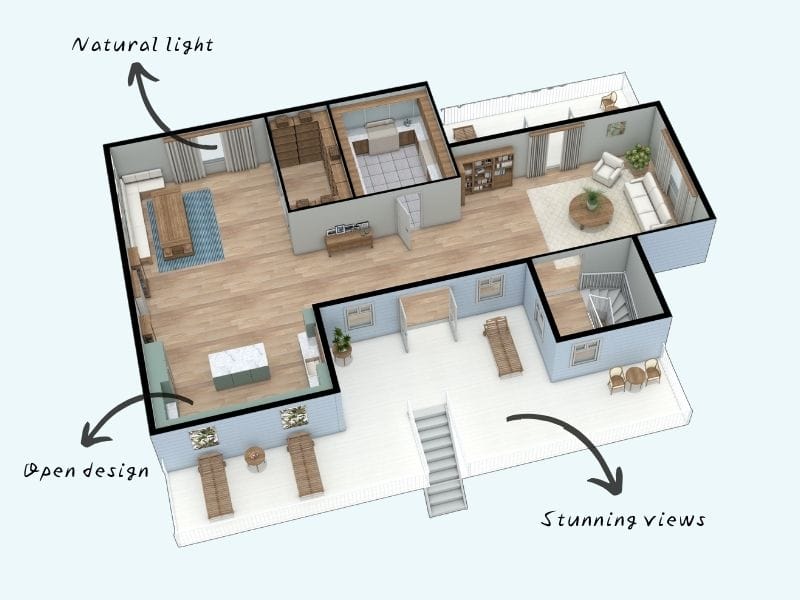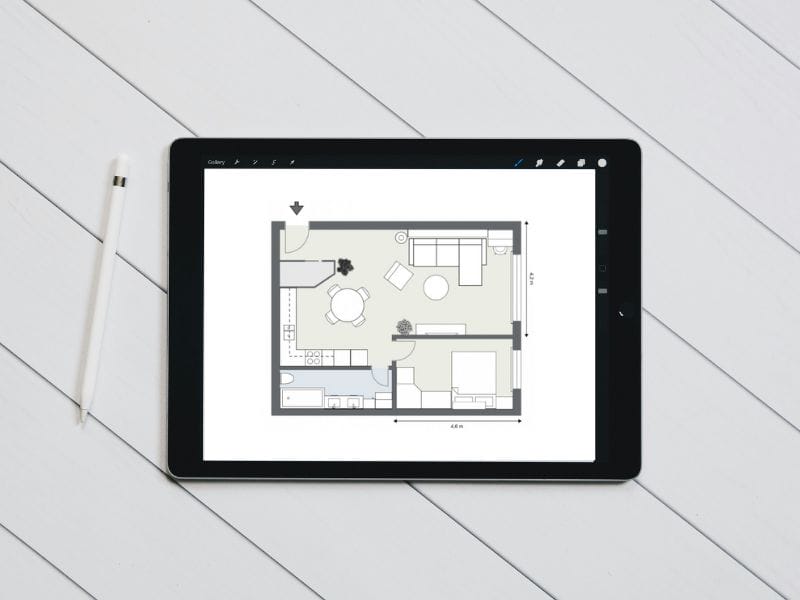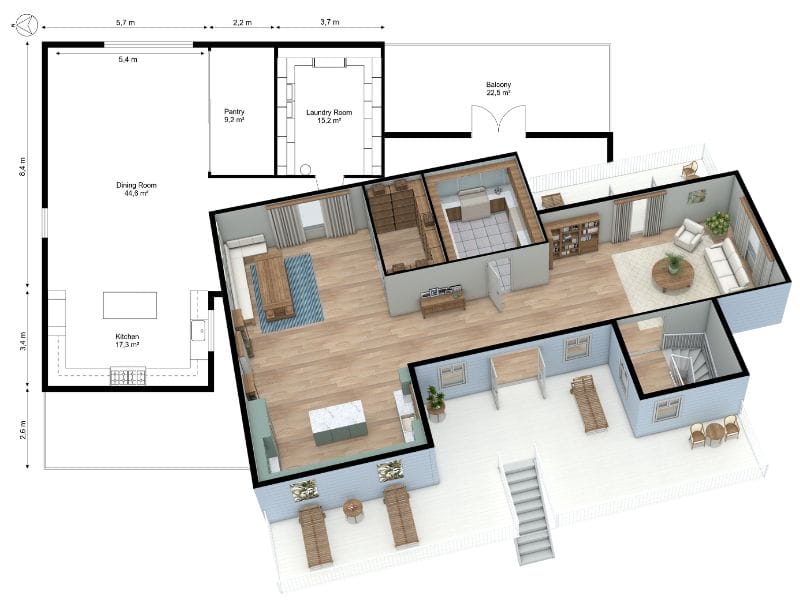What Is a Reverse Floor Plan? Understanding the Pros and Cons
Want a home that feels like a retreat with panoramic views and open, sunlit spaces? A reverse floor plan might be your perfect match.

✍🏻 Article Summary:
- Reverse floor plans place the main living spaces like the kitchen and living room upstairs and bedrooms downstairs
- Key features include open-plan upper floors, large windows, easy access to outdoor spaces, and private lower-level bedrooms
- Benefits include enhanced views, increased natural light, improved privacy, and flexible, modern living spaces
- Challenges include the daily use of stairs impacting accessibility and potentially harder resale due to the non-traditional layout
Reverse floor plans are turning traditional home design on its head and gaining traction among homeowners and architects.
In this article, we’ll break down what a reverse floor plan is, explore why it’s becoming a sought-after trend, and help you weigh the pros and cons to see if it’s the right fit for your next project.
What Is a Reverse Floor Plan?
A reverse floor plan, sometimes called reverse living or an upside-down home, flips the usual layout on its head.
With this design, the kitchen, dining, and living room are placed upstairs, while bedrooms and private spaces are located downstairs.
This approach is especially popular for homes on sloped lots or in scenic locations, where maximizing sunlight and capturing beautiful views are key priorities.
💡Terminology Tip
In some places, “reverse floor plan” can also mean a mirrored (left-right flipped) version of a home’s layout, not just an upstairs-downstairs swap.
Whether you’re a client or a builder, double-check what your designer or team means to ensure everyone is on the same page.
Key Features of Reverse Floor Plans

Upper-level living spaces
In a reverse floor plan, the main living areas — kitchen, dining, and living rooms — are all upstairs. This setup lets you make the most of natural sunlight and enjoy great views every day.
Open-plan design
The upper floor in a reverse floor plan usually has an open layout with few walls, bringing the kitchen, dining, and living areas together in one open space.
This setup makes it easy to see across the whole floor and often has a focal point, like a kitchen island or a fireplace, that ties everything together.
Large windows and outdoor access
You’ll often find big windows that stretch from floor to ceiling, sliding glass doors, and balconies or terraces on the upper floor. These features are usually positioned to capture the best views and sunlight throughout the day.
Outdoor spaces like balconies or terraces vary in size but are designed to feel like a natural extension of the indoor living area.
Private lower-level bedrooms
In a reverse floor plan, bedrooms and other private rooms are usually found on the lower level. This setup naturally separates the quieter sleeping areas from the busy living spaces upstairs.
Modern materials and finishes
Homes with reverse floor plans often use modern materials like glass, steel, and concrete. These materials give the space a clean, simple look that feels fresh and up-to-date without being over the top.
You’ll usually see lots of smooth surfaces and straight lines, helping the home feel open and uncluttered.
Benefits of Reverse Floor Plans

Maximized views and natural light
Putting the living spaces upstairs means you get better views and more natural light throughout the day. It makes the rooms feel bright and open, and you don’t have to rely as much on lamps or overhead lights.
Natural light can lift your mood and make everyday activities — like cooking, reading, or relaxing — more enjoyable. Plus, those views give your home a peaceful, inviting atmosphere that’s hard to beat.
Potential energy efficiency
In some climates, having the living spaces upstairs can help with energy use. The upper floor can soak up the sun’s warmth during cooler months, while the bedrooms below stay cooler in the summer.
Of course, this works best when the home is well-insulated and windows are placed thoughtfully, along with good heating and cooling systems.
It’s a smart way to keep things comfortable without wasting energy.
Enhanced privacy
With bedrooms downstairs, there’s a clear split between the social spaces and the quiet, private areas.
This setup works great for families — kids can hang out with friends downstairs without disturbing the main living areas. When it’s time to wind down, everyone heads upstairs to relax.
Having bedrooms on the lower level also helps keep things peaceful, since noise from the busy living spaces doesn’t travel down as much. It’s a simple way to create a calm, comfortable home for everyone.
Flexible and modern living
The open-plan layout upstairs, along with easy access to outdoor spaces, creates a modern way of living that’s perfect for both relaxing and entertaining.
It gives you the freedom to arrange your space how you like and enjoy time with family and friends, all in a bright, welcoming environment.
Whether you’re hosting a casual get-together or just unwinding after a busy day, this flexible design adapts easily to your needs.
Challenges and Considerations

Accessibility and daily effort
One of the biggest challenges with reverse floor plans is the extra effort involved in going up and down the stairs throughout the day.
Since the kitchen, living, and dining areas are upstairs, you’ll find yourself carrying groceries, laundry, or even small kids up and down regularly.
This can be tiring, especially for seniors, people with mobility issues, or families with young children.
Without easy alternatives like stair lifts, the stairs can become a real barrier, making everyday tasks more difficult and limiting accessibility for some residents.
Resale considerations
Reverse floor plans aren’t as common as traditional layouts, which can affect how easy it is to sell your home later on.
Some buyers may prefer the main living areas on the ground floor and might be hesitant about the upstairs setup.
This means your home could appeal to a smaller group of buyers, potentially impacting resale value or time on the market.
It’s something to keep in mind if you think you might move in the future.
Recommended article: Open vs Traditional Floor Plans: The Impact on Property Value
Who Should Consider a Reverse Floor Plan?

Reverse floor plans offer a unique way of living that suits different lifestyles. Here are some examples of people who often find this layout works really well for them:
- People with great views: If you want to make the most of sunlight and scenery every day.
- Families who want space: When you need a clear separation between busy living areas and quiet bedrooms.
- Fans of open layouts: If you like a modern, open feel that’s a bit different from the usual.
- Those who entertain often: When you want easy access between indoor rooms and outdoor spaces for guests.
If any of this sounds like you, a reverse floor plan could be a great fit for your home.
Create Your Reverse Floor Plan with RoomSketcher

Designing a reverse floor plan is easy and fun with RoomSketcher. Whether you’re starting from scratch or tweaking an existing layout, our user-friendly software lets you draw, customize, and visualize your home in both 2D and 3D.
With RoomSketcher, you can:
- Create detailed floor plans quickly and easily
- Visualize your design in 3D to get a real feel for the space
- Experiment with different layouts to find what works best
- Add furniture and fixtures to see how everything fits
Looking for Inspiration?
Related Blog Posts

How to Choose a Floor Plan: 5 Essential Steps
Stuck trying to choose a floor plan and worried you'll make the wrong choice? Building or buying a home is a huge investment, and the layout is crucial. We're here to help you confidently navigate the process.

How to Read Floor Plans: 9 Easy Steps
Learn how to read floor plans with our easy-to-follow guide. We'll walk you through interpreting measurements, analyzing layouts, and making sense of symbols step by step.

10 Ways to Find the Floor Plan of a House
Access to floor plans is essential for homeowners, real estate agents, and prospective buyers alike. If you’re struggling to find the original blueprints for a home, don’t worry—there are several effective strategies to help you locate them.

